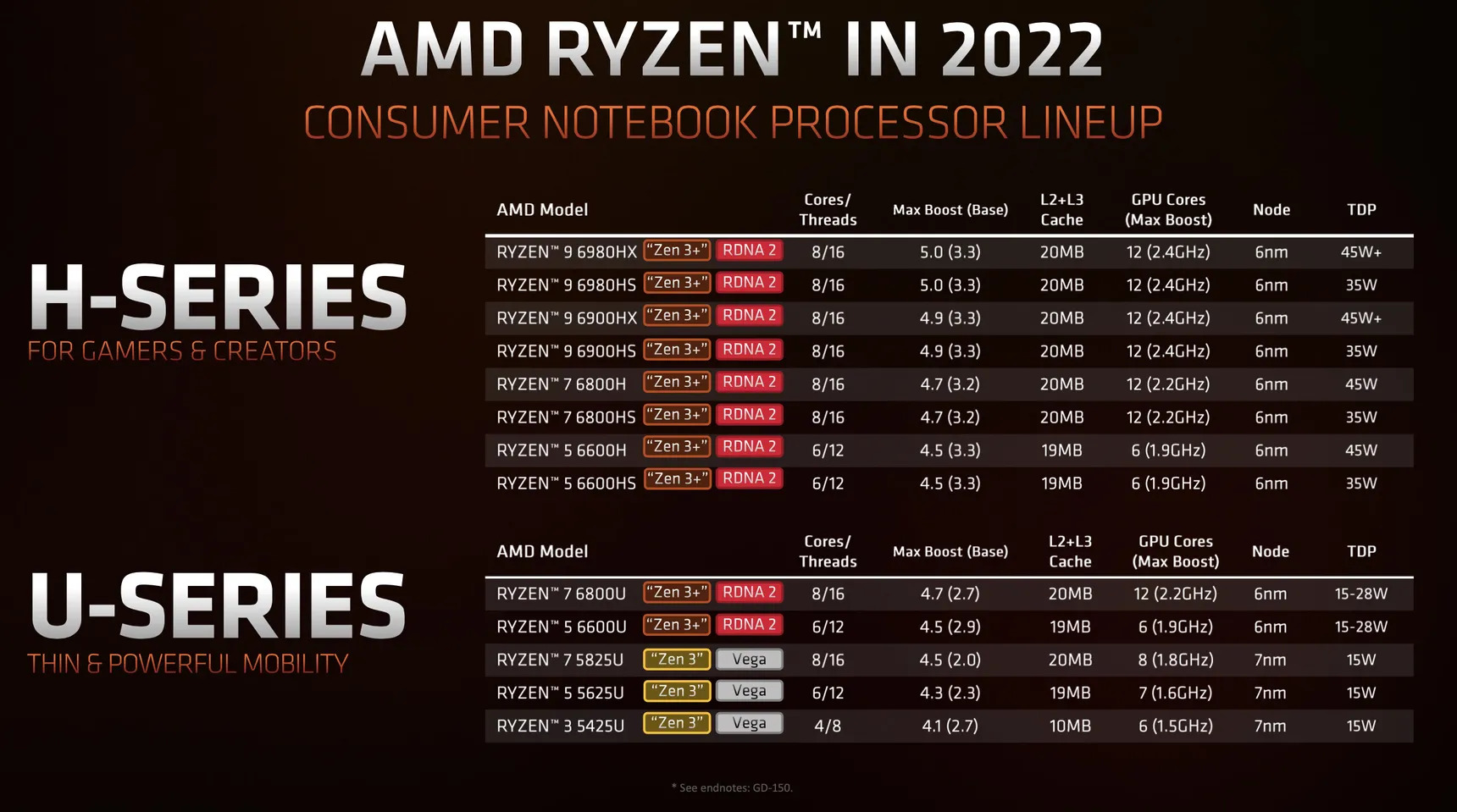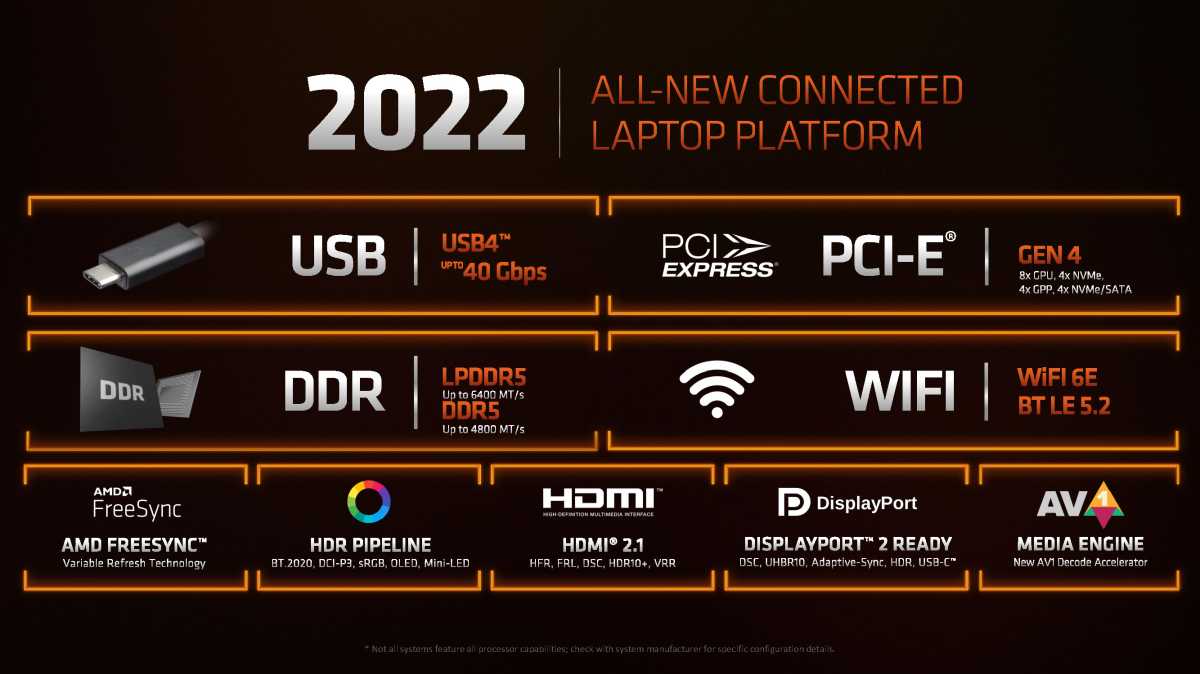Intel 12th Gen vs. Ryzen 6000 CPUs: Which one is better?
Can Intel’s 12th Gen CPUs fend off AMD’s Ryzen 6000?

CES 2022 featured a number of incredibly compelling new laptops, some of which earned our best of CES 2022 award. A big part of our excitement is the new Intel 12th Gen and AMD Ryzen 6000 chips found inside them.
AMD has been on a roll since the release of the Ryzen 4000 series, grabbing market and mindshare from Intel thanks to solid performance and superior battery life; the company claims 200 laptop designs will launch with AMD inside this year. However, don’t count out Intel just yet, it’s still the leader in the laptop market and Alder Lake may signal a turning point for the company against its resurgent rival as it’s a significant update to Intel’s architecture.
We’ll see Intel 12th Gen and Ryzen 6000 series processors across virtually every laptop category in 2022, so here’s a closer look at what you are getting.
- Best laptop 2022: 20 laptops for every use case and budget
- Flexispot BS1B Back Support office chair review
- The best laptop deals in January 2022
Intel 12th Gen vs. AMD Ryzen 6000: Performance
There is far more to these chips than just performance, but that is the first question that comes to mind for many users. While we wait to start testing laptops with these new components in the coming weeks and months, we currently need to stick to the claims made by Intel and AMD.
Intel’s top-tier Core i9-12900HK CPU will be a steep challenge for AMD to match this year as it offers 14 cores (six performance and eight efficient), while the flagship Ryzen 9 6980HX is limited to eight cores. It’s not an apples-to-apples comparison due to the differing architecture, but from a pure specs standpoint, that is undoubtedly a win for Intel.

AMD made the bold statement that Ryzen 6000 will offer twice the 1080p gaming performance of the Ryzen 7 5800U and a 125% improvement in 3D rendering, but we’ll find out soon enough if it can deliver on that promise. Intel said its new chips were 49% faster than the Ryzen 5000 series for gaming, but again with no one precisely lining up their points of comparison, it’s impossible to state how that will shake out until we’ve tested both. Intel did
While the flagship performance will be an exciting battleground, the mid-tier CPUs may be the more intriguing story. Intel’s brand new P-series CPUs offer 28W, compared to 9W or 15W in its U-series, which will allow for vastly more power in thin-and-light laptops. AMD’s biggest counterpunch here is the introduction of its RDNA 2 graphics cores to its integrated graphics, which I’ll touch on later.
Sign up to receive The Snapshot, a free special dispatch from Laptop Mag, in your inbox.

Intel 12th Gen vs. AMD Ryzen 6000: Battery life
While testing will definitively prove this one out, AMD should win again in this generation due to its enhanced 6-nanometer manufacturing process versus Intel’s 10nm. That’s simply too significant of a hurdle for Intel to overcome even with its new and improved architecture.
AMD is claiming up to 24 hours of video playback with Ryzen 6000. While that’s not a battery life measurement that I love, it’s a useful point of comparison. AMD claimed 21 hours of video playback for Ryzen 5000 series last year, so we can expect roughly a 14% boost.
For its part, Intel has remained pretty silent on battery life claims for its new CPUs, suggesting there won’t be any massive gains there. The one exception here may be performance-focused thin-and-light laptops that may have previously opted for the H-series chips, now have the P-series available, which will sacrifice a bit of performance for longer battery life.

Intel 12th Gen vs. AMD Ryzen 6000: Integrated graphics
Gamers won’t be trading their gaming laptops in for laptops with integrated graphics anytime soon, but both Intel and now AMD have made considerable strides in this arena, making at least casual gaming a possibility without discrete graphics.
Intel’s Xe integrated graphics last year were a massive leap forward, although we still don’t find them sufficient to play most AAA titles, but AMD may have a case for 1080p gaming with Ryzen 6000. The company asserts that its new RDNA 2-based graphics cores offer as much as a 303% increase in performance over Intel Iris Xe. That may be enough to challenge low-end GPUs (think Nvidia MX, not RTX), and if you are just an occasional gamer, that might be enough for you.
While gaming is the more mainstream focus, this boost to integrated graphics is also a boon for 3D rendering, with AMD claiming a 2.3x increase over its previous generation, and on the other side Intel indicates users can expect a 43% improvement. Creators are a hotly contested category, so this is an area that laptop manufacturers are paying close attention to.
While everyone is saying the right things, we’ve been disappointed too many times by integrated graphics performance versus bold claims made at announcements, so we’ll withhold final judgment until we get them in for testing.

Intel 12th Gen vs. AMD Ryzen 6000: Memory and Storage
While the rest of the components paired with these chips are up to the manufacturers, Intel and AMD offer slightly differing support for both memory and storage.
AMD’s Ryzen 6000 is limited to DDR5-4800 and LPDDR5-6400 RAM, while Intel’s 12th Gen allows you to use DDR5-4800, LPDDR5-5200, DDR4-3200 and LPDDR4x-4267. That’s probably not going to be the make-or-break decision for you on your next laptop, but manufacturers likely appreciate the added options, particularly given the frequent component shortages.
Storage also seems to tip slightly in favor of Intel. Both company’s offer an x8 PCIe 4.0 connection and a pair of x4 NVMe SSD connections. However, AMD uses the secondary x4 NVMe to cover a SATA connection as well, while Intel has a distinct SATA connection. This may seem like splitting hairs, this is likely a negligible speed difference, but it’s there.

Intel 12th Gen vs. AMD Ryzen 6000: Ports
The elephant in the room is Thunderbolt 4, which AMD cannot offer. However, Ryzen 6000 supports USB 4, which delivers a very similar experience with up to 40Gbps of bandwidth. If you go with an AMD Ryzen 6000 laptop, the main takeaway is that you’ll need to be a little more wary when purchasing a USB Type-C hub to ensure that it supports USB 4 and not just Thunderbolt 4.
On the other hand, Intel has one notable omission, and that is native support for HDMI 2.1, which Ryzen 6000 does offer. Intel may have deemed it unnecessary as gaming laptops and creator-focused laptops will still have this covered with Nvidia GeForce RTX 30-series GPUs supporting HDMI 2.1, but it may be a point in AMD’s favor for some.

Outlook
We can’t settle this face-off definitively until we start getting laptops with both Intel 12th Gen and Ryzen 6000 processors in for testing, but both make a compelling case for themselves.
AMD is a virtual lock to win the longevity battle again, particularly when weighing performance against that battery life. Intel’s forthcoming low power 9W or 15W 12th Gen U-series may be able to outlast them, but depending on your needs, that may not be worth the performance sacrifice. This is where Intel’s 28W P-series chips come in, but we’ll have to see how effectively they stack up against AMD’s 6nm chips.
High-end gaming performance when paired with the latest Nvidia GPUs may still tip in favor of Intel, however, this isn't a settled fact just yet. For the casual gamer that isn’t planning to spring for a true gaming laptop with a dedicated GPU, it seems like AMD may have the edge this year.
With AMD reportedly on track to power more laptops than ever in 2022, it seems that the company’s new chips have swayed manufacturers. However, Intel’s 12th Gen surprised everyone on the desktop last fall and may be poised to do so again in laptops.
While we can’t wait to put laptops running Intel 12th Gen and Ryzen 6000 through their paces and crown a winner for this round, it seems like either way it’s going to be an excellent year for laptop buyers as the competition (including from Apple) is spurring both on.
Sean Riley has been covering tech professionally for over a decade now. Most of that time was as a freelancer covering varied topics including phones, wearables, tablets, smart home devices, laptops, AR, VR, mobile payments, fintech, and more. Sean is the resident mobile expert at Laptop Mag, specializing in phones and wearables, you'll find plenty of news, reviews, how-to, and opinion pieces on these subjects from him here. But Laptop Mag has also proven a perfect fit for that broad range of interests with reviews and news on the latest laptops, VR games, and computer accessories along with coverage on everything from NFTs to cybersecurity and more.

